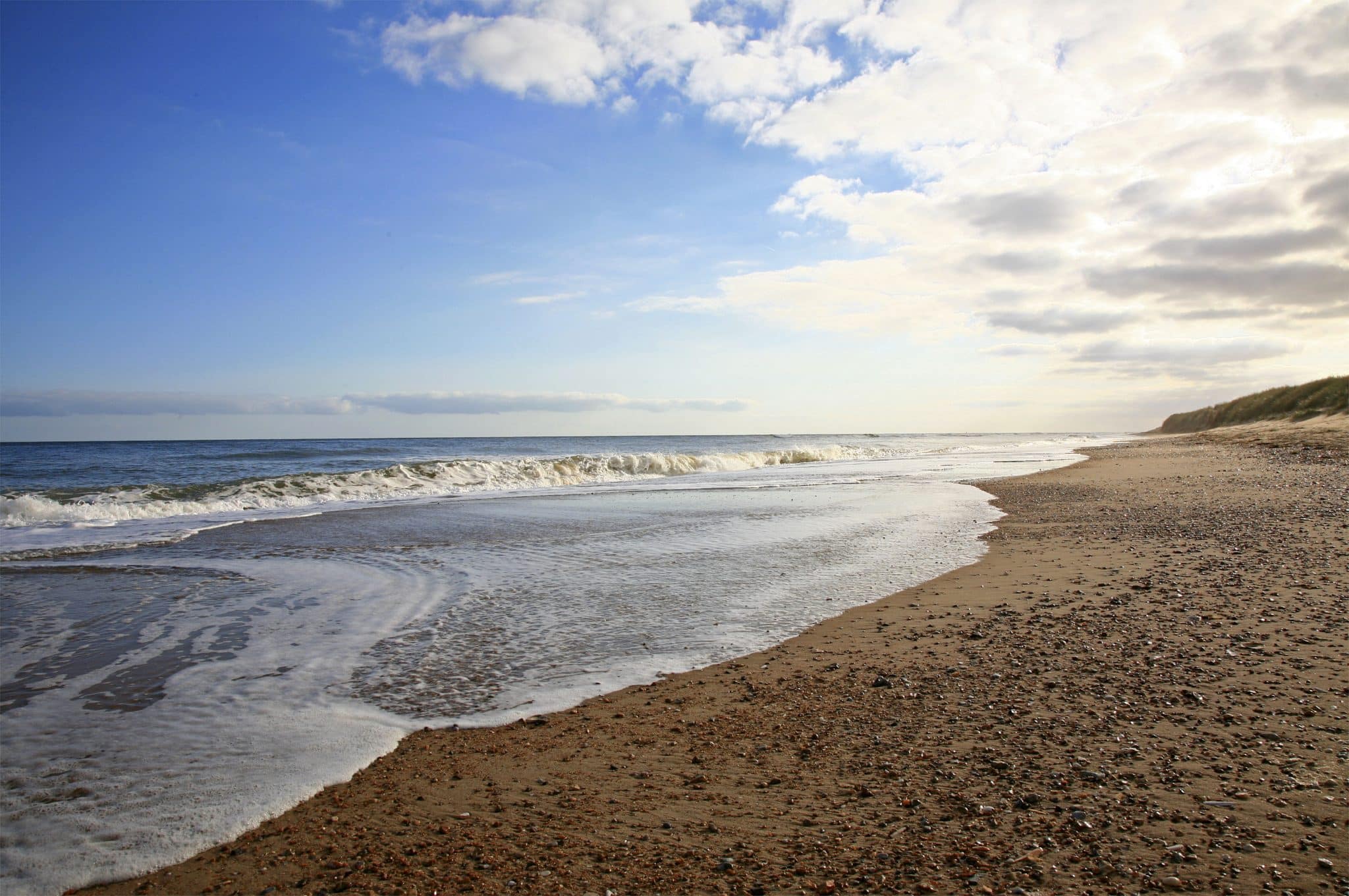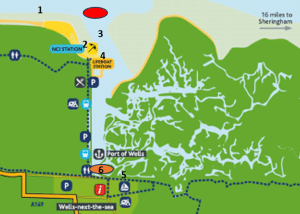
Safer sea swimming at Wells
March 12, 2024 | Holiday tips | 6 minute read
Hi, my name is Mandy. I look after the Wells RNLI Water Safety and I’m also crew on the Wells lifeboats. I love swimming in Wells all year round, whether it’s a beautiful sunny day or there’s snow on the ground. To make sure everyone gets to enjoy our beautiful waters as safely as possible, I wish to share with you some of my personal experiences and tips I’ve learned from the RNLI on how to swim safely in the waters around Wells.
When?
You will soon notice that the tide in Wells goes out a long way which means it has a big distance to cover coming back in before each high tide. You won’t be able to swim against this fast-flowing tide. The first thing we can all do to help ourselves is to swim when the water is flowing at its slowest. That means you should look to swim one hour either side of high and low tide. When planning your swim, use printed tide timetables or apps to see when high and low tides are, or visit our website. Make sure you use the tide time nearest to where you are entering the water (e.g. Wells Bar time for the beach and Wells Town for the slipways by the marshes).
Getting in. It’s a good idea to…
Carefully choose where you enter the water. If the water is moving you may want to take this into account before you get in – as I’ve already said, the currents in Wells are very strong! When swimming, it’s highly advisable to keep well away from boats, both those that are moving and those moored up. In the case of moored boats, currents can drag you under the boat whereas there is always the possibility of being hit by a moving boat if the helm hasn’t seen you in the water. Always stay away from the back of boats when you are in the water as propellers can cause life-changing injuries. Carry a means of calling for help (such as a fully charged phone in a waterproof pouch, round your neck). The sea is always cold (even in the summer!), so get used to the water slowly and enter gradually to reduce the risk of cold-water shock, which can lead to drowning. Be seen! As mentioned above, if a boat can’t see you there’s the possibility you could be hit. This can easily be remedied by wearing a brightly coloured hat and/or using a fluorescent tow float which really makes you stand out and gives you something to hang on to if you need a rest. If you can it’s also a good idea to go in a group. You’ll probably have more fun and a few people are much easier to spot than one.
Where?
The map below shows Wells beach, harbour and marshes. Bear the following in mind when considering swimming at any of the numbered points:
1. Main part of the sea: when swimming in the main part of the sea, swim parallel to the beach instead of going out into the water any great distance. As you go offshore the movement of the tides is up and down the coast, rather than in and out. Also avoid swimming near Harbour mouths (red oval) or creek entrances. The seabed consists of uneven sandbars which can mean you are in your depth one minute and out the next, it’s good to be aware.
2. Designated swimming area: is marked by the yellow buoys in front of the beach huts. In my view, this is the number 1 place to swim in Wells at Wells Bar high tide.
3. Swimming in the channel: the channel at low tide can also be fun, although I always keep well away from the Harbour mouth (red oval). When the tide is going out large volumes of water are being funneled very quickly back to the sea, so being swept out to sea is a real risk! Take care swimming in the channel, the water is deep (because it’s dredged), and the flow is fast. Avoid this when the tide is going out. Also keep out of the areas marked with the red & green buoys – this is where boats will be moving in and out of the Harbour, and remember, swimmers can be difficult for helms to see! I always look to stay near the sides, you’ll be out of the way of boats and if you get tired, you’re already close to safety.
4. Lifeboat Station slipway: avoid the area and water around here as the lifeboats could be launched at any moment. The current picks up around there too!
5. Slipways in town: there are a few slipways down on the East Quay (by Shipwrights, the Sailing Club and by the Whelk sheds. These are mostly used for getting boats in and out of the water so take care and keep away from any boats when in the water. The water moves fast here so only swim around Wells town high tide here.
6. Main Harbour area by Harbour Office: never swim in the main part (orange oval) of the Quay large boats are moving and they won’t be expecting swimmers!
What to do if…
Even the most experienced swimmer can find themselves in difficulty. If you find you’ve lost control of your breathing because you’ve entered the water too quickly or you’ve been in too long – float! Lie on your back and make a starfish shape. Stay as calm and relaxed as you can and when your breathing is under control call for help, or swim to safety.
If you see someone in the water in trouble our instinct is often to go into the water to help. This is NOT recommended. The best way you can HELP is to call 999 immediately. Do not enter the water. Encourage the person to float on their back. Look around for anything you can throw to help them float such as a life ring. Keep watch and encourage them until help arrives.
I hope you now feel totally clued up on how to swim around this area more safely.
Before I go, a very quick recap:
1. Stick to swimming at high/low water – use the tide time nearest where you are entering the water.
2. Keep well away from boats, especially the propellers.
3. The designated swimming area on Wells beach, in front of the beach huts is my number 1.
4. Avoid the harbour mouth, where it joins the sea, and the main part of the Quayside, by the Harbour Office.





